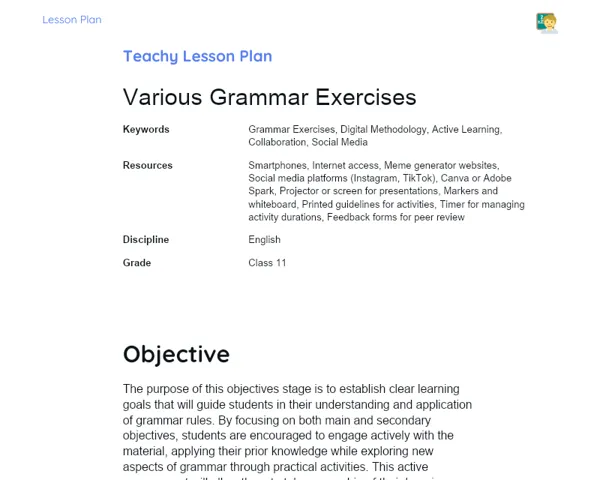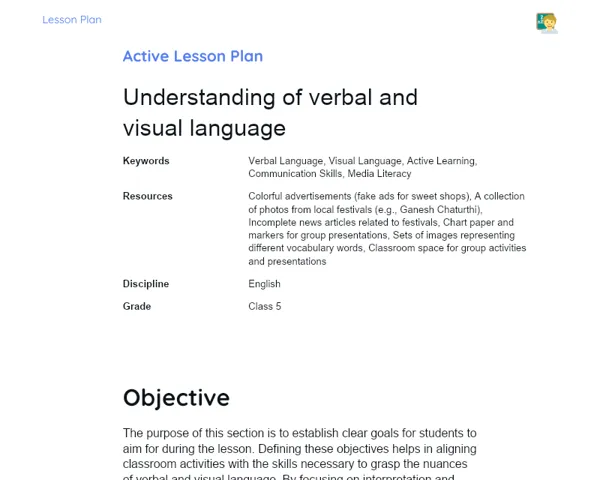Lesson Plan | Socioemotional Learning | Structure of a Book Review
| Keywords | Book Review, Structure, Emotional Vocabulary, Self-Awareness, Self-Management, Responsible Decision-Making, Social Skills, Social Awareness, RULER Method, Introduction, Summary, Analysis, Conclusion, Guided Deep Breathing, Collaborative Learning |
| Resources | Whiteboard and markers, Paper or digital writing tools for book reviews, Books for students to choose from (local and popular children’s books), Handout with key components of a book review, Emotional vocabulary list, Comfortable seating for guided breathing activity, Quiet space for reflection discussions, Goal-setting worksheets |
| Codes | - |
| Grade | Class 6 |
| Discipline | English |
Objectives
Duration: (10 - 15 minutes
The purpose of this section is to set clear expectations for students regarding their learning outcomes during the lesson. By articulating these objectives, students will understand what they are expected to learn about the structure of a book review, as well as how to connect their reading experiences with their emotions. This dual focus on cognitive and affective competencies helps students to not only grasp the academic content but also cultivate their emotional intelligence, thereby enhancing their ability to express opinions and experiences effectively.
Main Objectives
1. Students will identify the key components of a book review, such as the introduction, summary, analysis, and conclusion.
2. Students will develop emotional vocabulary by recognizing and labeling their feelings about different books.
Introduction
Duration: (15 - 20 minutes)
Emotional Warmup Activity
Breathe In, Breathe Out: A Journey Within
Guided Deep Breathing
1. Ask students to sit comfortably at their desks with their feet flat on the floor and hands resting on their laps.
2. Instruct them to close their eyes gently and take a deep breath in through their nose for a count of four, feeling their abdomen expand.
3. Hold the breath for a count of four, encouraging them to notice any tension they may feel.
4. Slowly exhale through their mouth for a count of six, letting go of any stress or distraction.
5. Repeat this deep breathing pattern five times, reminding students to focus solely on their breath and the sensations in their body.
6. After the fifth breath, ask students to open their eyes slowly and bring their focus back to the classroom.
Content Contextualization
In our fast-paced world, the way we react to a story can reflect our emotional experiences. Think about the last time you read a book that made you feel a whirlwind of emotions—excitement, sadness, or even anger. These feelings not only shape our understanding of the stories we read but also influence how we communicate our thoughts to others. Writing a book review is not just about summarizing what happened; it's an opportunity to connect deeply with the characters and themes and articulate what those experiences meant to us. Engaging with a book allows us to explore our own emotions and learn how to express them effectively, which is essential for building social skills and forming connections with others.
Development
Duration: (60 - 75 minutes)
Theory Guide
Duration: (25 - 30 minutes)
1. Introduction: Explain the purpose of a book review, which is to share a reader's experience and evaluation of a book, helping others in the choice of their next read.
2. Key Components: Detail the major components of a book review: Introduction (includes the book title, author, genre, and a brief statement of the review), Summary (a concise overview of the plot without giving spoilers), Analysis (evaluation of characters, themes, writing style, and personal impressions), and Conclusion (summary of key points and a recommendation). Use local examples from popular children's books to make it relatable.
3. Structure: Discuss the importance of organizing thoughts logically in the review. For instance, if using 'Harry Potter and the Sorcerer's Stone', explain how to introduce the book, summarize key plot points like Harry discovering he is a wizard, analyze the characters (e.g., Harry, Hermione, Ron), and conclude with whether the book is worth reading.
4. Emotional Connection: Talk about how personal feelings about the book can shape the review. Encourage students to reflect on the emotions they felt while reading (e.g., excitement during a climactic scene, sadness during a dramatic moment) and how to incorporate those feelings into their writing.
Activity with Socioemotional Feedback
Duration: (15 - 20 minutes)
Creating Our Own Book Reviews
In this activity, students will choose a book they have recently read and write a structured book review based on the components discussed in the theory section. They will focus not only on summarizing the plot but also on analyzing their feelings and reactions to the story, ensuring they express those emotions in their reviews. This will be done in pairs, allowing students to collaborate and provide mutual support.
1. Ask students to pick a book they have read recently and provide them with paper or digital tools for writing their reviews.
2. Encourage each student to create an outline based on the key components discussed: Introduction, Summary, Analysis, and Conclusion.
3. In pairs, have students share their outlines and discuss their emotional connections to the book, helping them refine their reviews based on feedback.
4. Allow time for each pair to write their reviews, encouraging them to incorporate emotional vocabulary learned throughout the lesson.
5. Once finished, organize a reading circle where each pair can read their reviews aloud to the class.
Discussion and Group Feedback
After the reading circle, gather students for a reflective group discussion on their experiences of writing and sharing their book reviews. Begin by helping them Recognize their emotions during the activity; ask them how they felt when writing or sharing their reviews. Facilitate an understanding of why they felt that way, discussing potential causes such as excitement, nervousness, or pride in their work. Encourage students to label these emotions accurately, using terms discussed earlier, such as 'nervous', 'excited', or 'confident'. Next, guide them to express these feelings openly, fostering a supportive environment where each student can share their thoughts on both their reviews and the emotional process involved in writing them.
Conclusion
Duration: (15 - 20 minutes)
Reflection and Emotional Regulation
To conduct a reflection, the teacher can start a circle discussion where each student shares a challenge they faced while writing or presenting their book review. The teacher encourages students to express their feelings about these challenges, such as frustration or excitement, and explores how they managed those emotions. For effective engagement, the teacher may ask guiding questions like 'What was the most challenging part of writing your review?' and 'How did you feel when you were sharing it with the class?' This discussion should highlight both individual feelings and strategies for coping with challenges.
Objective: The objective of this subsection is to cultivate self-assessment and emotional regulation among students. By reflecting on their challenges and discussing their emotional experiences, students can identify effective strategies for managing emotions and enhancing their resilience, ultimately improving their coping mechanisms in academic and social settings.
Glimpse into the Future
To conclude the lesson, the teacher can guide students in setting personal and academic goals based on what they learned about book reviews and emotional connections. This could involve students writing down one specific goal they want to achieve in their reading or writing, such as 'I will read two new books each month and write a review for each,' or 'I will practise sharing my reviews in smaller groups before presenting to the whole class.' This activity reinforces the concepts learned and encourages forward thinking.
Setting Goals:
1. Read and review two new books every month to explore varied genres.
2. Practice sharing reviews with peers in small groups to build confidence.
3. Develop a personal reading log to track emotions and insights related to the books read.
4. Incorporate emotional vocabulary learned in daily conversations about reading. Objective: The objective of this subsection is to strengthen students' autonomy and practical application of the lesson's content. By establishing personal and academic goals, students are encouraged to take ownership of their learning journey, fostering a sense of responsibility and commitment to their development, both academically and emotionally.


